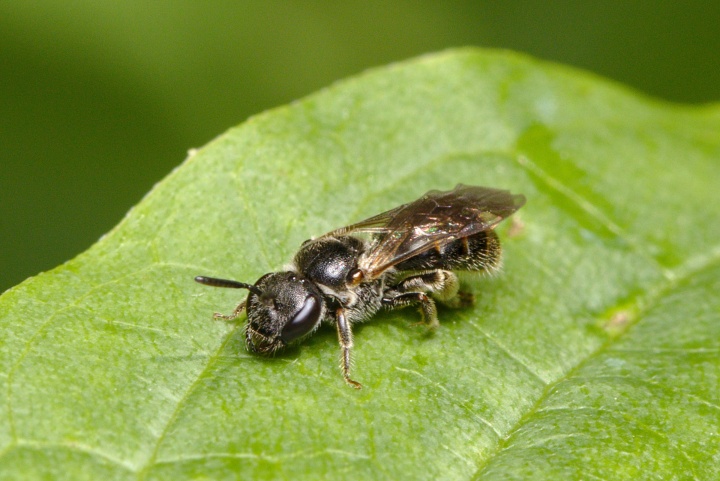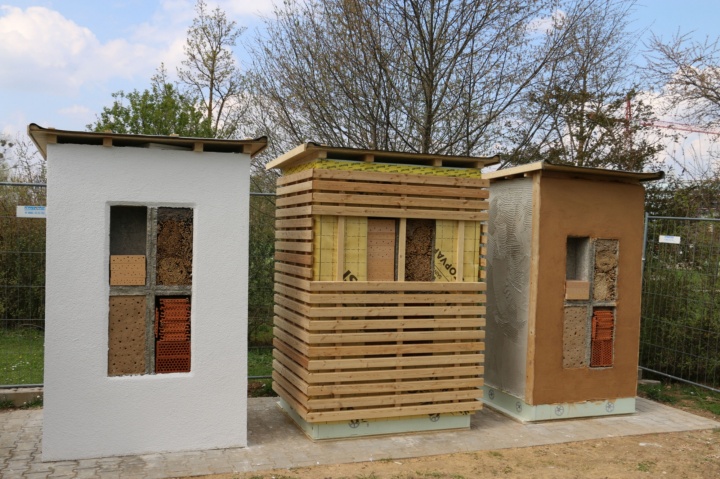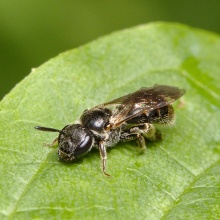“Actually, an ‘insect hotel’ is not a hotel at all. But the term helps to imagine what I’m working on,” explains Linda Meier. She has been a research assistant at the Institute for Acoustics and Building Physics (IABP) at the University of Stuttgart since 2017. Her research: facade-integrated nesting aids for wild bees.
In fact, wild bees do not need hotels. Among other things, they like to sleep on leaf stalks. However, they sometimes look for suitable cavities to lay their eggs. This is where Meier’s research topic comes into play.
Better insulation – consequences for nature
For birds and bats, there are already concepts in which nesting aids are attached to buildings or inserted directly into the exterior wall. If, for example, a pair of black redstarts has settled ahead of a planned renovation that includes roof and facade insulation, then the renovation is only permitted if an alternative habitat is provided for the birds. It is illegal to simply throw them out. There are companies that specialize in these alternative habitats.

With insects, it’s a different story. To date, there has been little research in building physics on facade-integrated habitats, and there are few legal requirements for them. Meier focused on the wild bee. Wild bees need two things to survive: flowering plants as food for themselves and their larvae, and suitable nesting opportunities with material for building nests. Due to human intervention in the ecosystem, both have declined to such an extent that more than half of the wild bee species in Germany are on the Red List. Meier relies on solutions from building physics against the extinction of species.
Greenery-covered buildings with facade-integrated nesting aids
“Of course, it’s not enough to provide nesting opportunities – we need to think in larger contexts,” Meier explains. Flowering plants are needed to ensure that food is also available, preferably a mix of plants that provide food throughout the year and into October. Therefore, the scientists at the IABP also look at facade and roof greening and consider (potential) green spaces in the vicinity.
The parking lot at Pfaffenwaldring is swarming with bees
This does not remain a theory. If you stroll across the parking lot at Pfaffenwaldring on the Campus Vaihingen, you can find wild bees. There, the Wilhelma zoo sowed a special mix of flowers. Just like in Nobelstrasse, which is about a kilometer away, Meier has recently set up her test facades at this location. The facades combine common construction methods, either brick walls or lightweight timber construction. Nesting aids in wood cement frames are integrated in the facades. The building physicist filled the nesting aids with a clay mixture and pre-formed nesting holes in them – for the wild bees to finish. Reed tubes of various diameters have also been used. They are already being used for building insulation, but for the bees they must be placed horizontally. Other materials used are fired clay and hardwood drilled with holes. Now only the bees are missing.

When man and nature live together and both benefit from it
For one year, Meier will observe the settlements and take building physics measurements. Temperature and humidity are particularly important, also with regard to future human neighbors on the inside of the facade. The heating of the building in winter is also to be simulated. Energy-efficient walls and roofs are harmonized with what is offered to the animals. “It’s intended to be comfortable for both humans and animals,” Meier emphasizes.
The IABP scientists always keep in mind the interaction of man and nature – an approach that is also socially accepted, explains Head of Institute Prof. Philip Leistner: “People’s acceptance of this development is definitely there, as our surveys have shown.” Pia Krause, Meier’s colleague, pursues the same objective with her research on the interaction of trees in front of buildings and the respective indoor climate. Ideally, trees help reduce interior energy consumption and improve the carbon footprint while preserving wildlife habitat.
Islands of green in the city
If the greenery around and on, for example, large university buildings is included, then “stepping stones” for animals and plants can be created even in cities: Some animal species and plant seeds cannot overcome a large-scale concrete wasteland, but if they repeatedly find islands of green, so-called stepping stone biotopes, then they can spread and mix the gene pool. In this way, rare species can be preserved. “You can achieve so much with small islands of green,” Meier says. Among other things, she is involved in the Girls Day, where she passes on her enthusiasm. She also emphasizes the relevance of environmental education for children to reduce alienation from nature.
Lastly, she gives us a piece of advice for home use: “Just leave the flower stalks after flowering - many insects retreat into the stems to hibernate inside them. It doesn’t always have to be tidy, sometimes clutter can be a habitat.”




